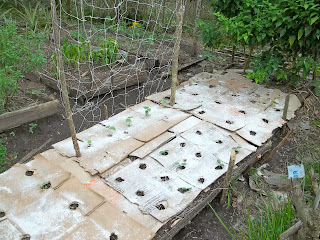This one is a long one. We have to cram all we've learned in the first 2 weeks here into one blog. Our internet is very limited so it has taken me 8 days not to put this together. And we've already learned so much more since I started this one!!!
For the month of July we will be living in our tent on Finca
de Los Perezosos - The Lazy Man’s Farm - owned by John Douglas. The farm is
about experimenting with permaculture (stands for "permanent agriculture") in a
tropical climate.
The goal of the farm is to educate other campesino’s (local
small scale farmers) who mostly use traditional slash and burn methods that are
very unsustainable. Slash and burn means they clear-cut the area that they intend to farm, and burn it in an effort to rid the area of debris. Burning all of this excess material causes the soil to lose the majority of its nutrients and the resulting ash can blow away easily and/or wash away with the torrential rain.
As a result of the loss of nutrients, farmers need to fertilize the soil, often with harmful chemicals.
One method that Marcelino, the super-cool Panamanian farm manager, and John implement and preach is called ‘chop and drop.’ It is exactly what it sounds like; the chopping of dry or dead leaves and branches and/or branches of the balo tree (an rapidly-growing nitrogen fixer) and the dropping of this organic material in a circle around the drip line of the food producing trees/plants, such as citrus, avocado, star fruit, papaya, etc. This organic material that is being "chopped and dropped" is a form of continuous compost, and the material will provide essential nutrients (carbon, nitrogen, phosphorus, etc.) directly to the roots of the tree, which results in a healthier happier plant that produces an incredible abundance of food.
The farm is more of an experiment than anything…John does not sell food, nor does he make any money. It by no means perfect, but John and Marcelino gained essential knowledge from their trials and tribulations. The ultimate goal is to teach others to farm sustainably and, in a sense, to imitate nature. When you observe nature (untouched/raw nature, like a forest or jungle) there are no monocultures (crops containing only a single plant). There is incredible diversity. The jungle contains a forest floor, an understory, and a canopy. Each level is home to different species performing different, but equally important, tasks.
Most importantly, permaculture focuses on the essential relationships between diverse plant species. There is much more to permaculture than just planting food for eating. Yes, some plants are for harvesting food, but just as many (if not MORE) plants are there for support (fixing nitrogen, accumulating nutrients in the soil, providing shade, keeping away pests, etc.). If done correctly, one can plant an entire area just once, and, after a few years of care, this area will never need maintenance, as nature would take it’s course and leave only the harvesting to the farmer (this is the idea behind a "food forest"). The idea is to reduce the work that you do to the land, and increase the work that mother nature does naturally. No tilling. No plowing. No clear cutting. Only Permaculture!
Enjoy the random pics and video's!!!
Funky bugs.
Nuestra casa. Our house. 2 weeks so far and only one flood. Well...not flood, but really really wet time in which we had to evacuate all of our stuff. Fun!
Mariposa grande. Big butterfly.
One of the tilapia aquaponic ponds.
One way to dramatically reduce your weeding....cover the ground with cardboard to smother the weeds around the plants.
Kimmy (another volunteer) harvesting a yuca. Yuca is a large root vegetable similar to a potato but much larger with a smoother, sweeter texture. A Panamanian staple. My favorite way to eat yuca is still from Diogo's mom. Her yuca is the best and I have yet to replicate it.
A cliff on John's property that Kyle and Pete (another AWESOME volunteer) have been perfecting their front flips and gainers on. Mom, you'd have a heart attack. Much scarier than watching me dive into a nice cliff-and-rock-free pool. Don't worry, it's deep with a sandy bottom.
Marcelino breaking the outer shell off the coffee bean to prepare for roasting.
Chop and drop baby!
Mixing compost....compost has many similarities to chili or spaghetti sauce recipe. Everyone has a favorite ingredient list, usually including a balance between nitrogen and carbon, water and oxygen, green and brown organic matter. This compost happens to be made largely of chicken poo, with a little ash, brown/dry banana leaves, and used sugar cane (called sugar cane bagasse, after the juice has been squeezed out).
Our outhouse, housing the composting toilet.
How to use the composting toilet
The camode. Super cool, super clean, super non-smelly.
Edible stuff on the farm....
peppercorn
Katuk....a perennial with leaves and pods that are amazing in salad!
Okinawa spinach...a perennial that's, again, super tasty in salad.
Little sweet peppers.
Cranberry Hibiscus. My favorite edible perennial. The red leaves look great in salad AND they have a tangy lemony flavor.
Star fruit.
Manzana de Agua. Water Apple. Tastes like a super crunchy, super juicy little apple.

















The jumping off the cliff video...your right...you said Mom just after I gasped for air...your timing was perfect.
ReplyDeleteLooks like you are having a great time and meeting wonderful people.
Did Yari leave for Canada yet?
NICE!!! I love that Idea, Maybe if you guys learn a lot about that you can share the technique a little more for farming in Guatemala and Nicaragua!! They do the same slash and burn techniques there.
ReplyDelete